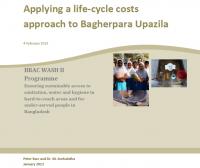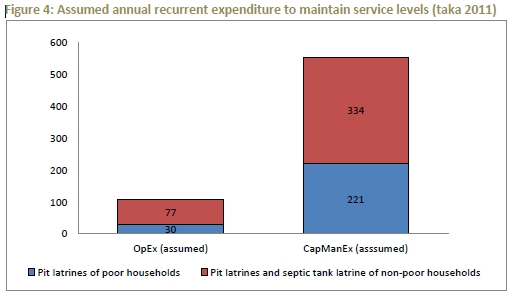This case study applies a life-cycle costs approach (LCCA) to the sanitation and hygiene activities undertaken in Bagherpara Upazila, Jessore District, Bangladesh from 2006-2011, the duration of BRAC WASH-I programme. This was done to evaluate the sustainability of the sanitation and hygiene achievements over BRAC WASH I, demonstrate the type of results that can be delivered by an LCCA, and to explore ways in which life-cycle costing could be integrated in the BRAC WASH II programme.
Published on: 15/05/2013

The life-cycle cost approach is a methodology developed by the WASHCost project of the IRC International Water and Sanitation Centre to explore the disaggregated costs of ensuring delivery of adequate, equitable and sustainable water supply, sanitation and hygiene (WASH) services to a population in a specified area.
The study found that the total expenditure for sanitation and hygiene in Bhagerpura Upazila was equivalent to US$ 406,000, of which 5% was for capital expenditure software to create demand for latrine construction, 36% for capital expenditure hardware to construct and upgrade latrines and 59% for direct support expenditure. The main focus of BRAC-WASH expenditure was found to be on activities that directly support service delivery, which equated to an expenditure of US$ 0.22 per person/per year.
Indicative assumptions suggest that household expenditure on operation and maintenance (OpEx), and on capital maintenance (CapManEx) to ensure the ongoing going delivery of a basic sanitation service represents up to 30% of the initial capital expenditure on latrines (fig. 4). For poor and hardcore poor households this could pose a significant risk to the sustainability of any service improvements.

The authors conclude that the life-cycle cost methodology can be easily integrated in the monitoring instruments of the BRAC-WASH II programme to enable a complete analysis of costs and service levels achieved and the potential towards sustainability.
Burr, P. and Snehalatha, M., 2013. Applying a life-cycle costs approach to Bagherpara Upazila. The Hague, The Netherlands: IRC International Water and Sanitation Centre, Dhaka, Bangladesh: BRAC. 26 p. : 4 fig., 15 tab. 15 May 2013
NB: This case study was updated in 2014 and you can find the updated version via the link below.